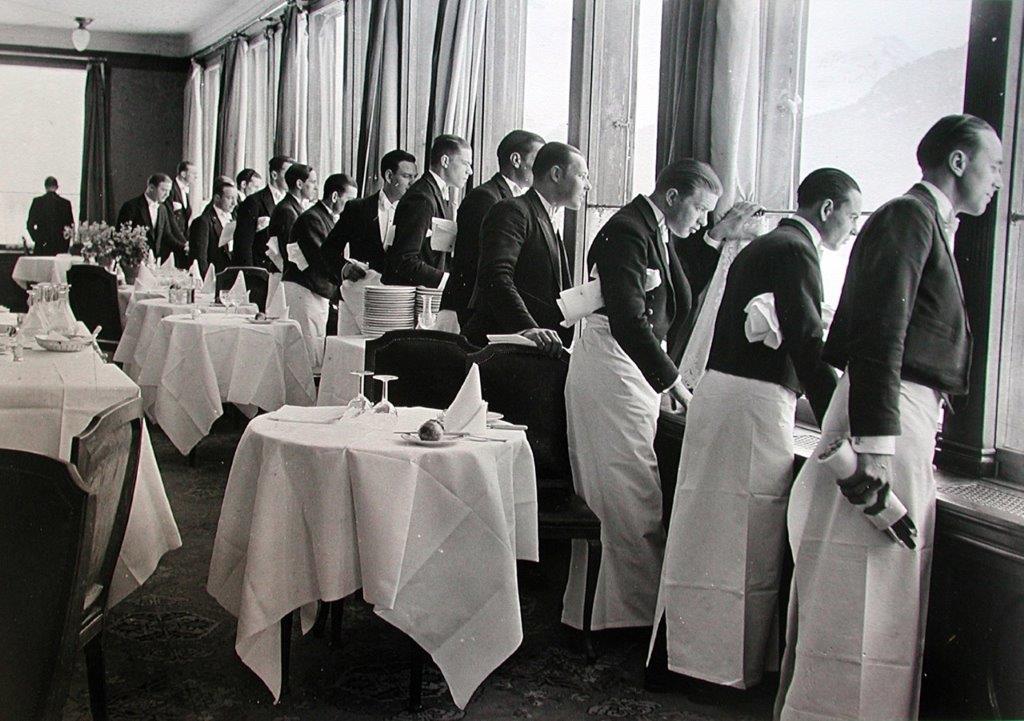Waiters Watching Sonja Henie Skate, 1932

After his death, one obituary referred to Eisenstaedt (1898-1995) as ‘photojournalism’s clever Fool – life’s court jester, cavorting with serious intent among the burlesque of celebrityland’.
It was this ability – employing a non-judgemental eye and finding an irresistible picture in any situation or event – that made him such a popular photographer with editors.
Eisenstaedt may indeed have spent his later years cavorting around celebrityland, but earlier on in his career he was a hardworking, driven photojournalist, never associated with any one genre, a reliable and respected generalist.
This, paired with his quick eye and ability to take perfectly composed images in an instant, all contributed to his stellar success.
Born into a comfortable middle class family in pre-WW1 Germany, Eisenstaedt’s father owned a department store, and was to give Alfred his first camera for his 14th birthday – an Eastman folding No 3. Clearly the gift awoke an early fascination with photography, as he soon fashioned a darkroom out of his bathroom to print his first pictures of city snowscapes.
When war broke out, the young man found himself becoming a war photographer. He was lucky enough to be sent home in 1918 with just shrapnel wounds, but upon his return he found his family impoverished. He took work as a button salesman to help bring in financial help, but would still photograph relentlessly in his spare time.
He was soon to be known as the ‘fanatical camera bug’, but when he succeeded in selling his very first photograph, it was the catalyst for his hobby to become his profession, and lifetime passion. As he explained ‘When I have a camera in my hand, I know no fear’
He would spend many hours in the darkroom, learning how an enlarger could alter composition simply by cropping the image. He continued to work hard and managed to save enough in order to buy more professional equipment.
The effort paid off – his work was in demand, and was able to find a ready market through the Pacific and Atlantic Picture Agency.
In 1935, after having covered the inexorable rise of Hitler, and capturing the byzantine and mercurial world of German politics, his work had tested the patience of too many people now in powerful positions, and Eisenstaedt fled to the United States.
He found the American audience distinctly difficult to please. New York newspapers and magazines didn’t appreciate the subtlety that had attracted European editors. His early clients – Vogue, Harper’s Bazaar, Town and Country – wanted slicker images.
However, Eisenstaedt’s reputation spoke for itself and when a new magazine started up in 1936, Eisenstaedt found a place on the staff. Offering vast new opportunities, Lifemagazine allowed Eisenstaedt to combine the candidness of his earlier photography in Germany with a new American directness. His work was instantly heralded.
As one of the first four photographers hired by Life, he would ultimately contribute over 2,500 picture stories and 90 cover photos.
‘Eisie’ as he was known, became drawn to subjects of stature and fame while at Life, and for thirty years he indulged his interest by photographing the world’s most prominent key figures, Kennedy, Nixon, Kissinger, even Winston Churchill. He also turned his lens on leading movie stars and performers, boyishly still spellbound by their glamour.
Seen here is one of most striking pictures, an unusual scene of all the waiters at the Grand Hotel in St Moritz lining up at the windows of the empty dining room. They were watching Sonja Henie, the three-time Olympic champion figure skater, who had also become a film star.
She was performing below, giving them a perfect bird’s eye view of her spectacular routine. The viewer is left intrigued about what is captivating this line-up of waiters, all peering down so intently.
Of course, Eisenstaedt is best known for his totemic image of a sailor passionately kissing a nurse during a V J-Day celebration in Times Square, as news broke of the Japanese surrender in World War II. It became a wonderful symbol of joy at the war’s end.
Despite its widespread recognition, and the fact that it was reproduced in so many news publications around the globe, one mystery remains. The identity of the sailor and nurse are still unknown to this day; they never came forward, and Eisenstaedt protected their desire for anonymity.
But Eisenstaedt was a contradictory character. Though he saw himself as an uncompromising but genial professional (he must have enjoyed the description of him by leading photographer Margaret Bourke-White as a ‘hostess’s dream’) his Life colleagues didn’t agree.
They viewed him as someone to be avoided at all costs, as he routinely demanded ‘so much care and feeding, so much mopping up and ego-nourishment that the reporter hardly had any time to write captions’.
However, Eisenstaedt had achieved a track record that was virtually impossible to match, with many hundreds of prize-winning contributions to the magazine.
Regardless of both the reverential, and the disobliging opinions he inspired, Eisenstaedt was, above all, a particularly smart photographer, who lingered with inconspicuous intent at heavyweight political gatherings, as well as exuberant celebrity functions.
He used his diminutive stature to create an unthreatening aura of childlikeness to put his subjects at ease, but pictured America with forthright, confident majesty. His legacy was well described when Henry Ford signed Eisie’s catalogue of his works with: ‘No nonsense and great pictures’.
